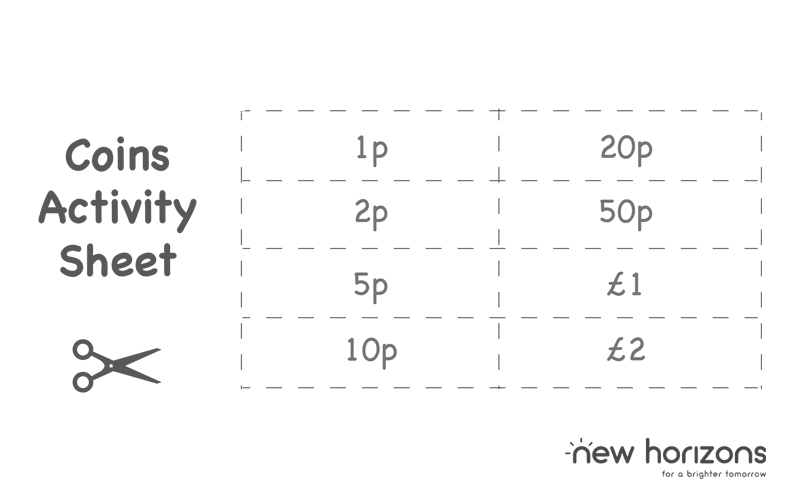Money is a force that will influence your child throughout their life. Making sure it’s something they can handle and manage is essential. And it’s never too early (or late) to start learning. Unfortunately, schools can be a little behind on teaching this important skill, leaving the only option of learning through trial and error – a dangerous tactic. To help, we’ve created the following guide. We hope it will help parents can teach their kids about money, from the value of each coin right through to saving and budgets.
Let’s dive in.

Identifying and Understanding Money
Most young children are unaware of which coin is which. As far as they’re concerned, they’re meaningless chunks of metal that are better for throwing and swallowing than for commerce. In fact, if you were to ask what coin a child prefers most, they’ll probably pick a £2 coin, as it’s the largest.
At this stage in life, simply showing them what each coin is and what it means is a good place to start. Playing a coin identification game provides a strong foundation to learn from. By taking a series of basic coins and a few pieces of paper, you can ask your child to correctly pair each coin with its respective name. Be patient and help them out when needed. In time, they’ll learn to correctly associate each coin with its name.
Now, be wary, as children of this age are likely to put most things they find in their mouth, including coins! Supervision at all times is essential. To help, we’ve created a simple mix and match game you can print off and cut out. Simply click the image below to open the worksheet in a separate tab and hit print.
Once they’ve become a master in coin management, upgrade them to notes. Again, repeat the above steps and get them to associate the right name with the right note. Although they might not swallow a note, be vigilant as they may try to rip them! The aim is to teach them about money, not how to destroy it!
Further activities to teach your kids the value of money
Once your children are adept at identifying the different coins and notes, or even while learning, it’s a good idea to start getting them used to handling money. Below, we’ve identified some fun games to play which will help teach your little ones how money really works.
1. Turn them into a cashier
Now, they are by no means ready to start working at the local shop! What we’re saying is that they should be given a chance to explore how money is exchanged for goods and how to use change with the assistance of a toy cash register.
Playing ‘store’ can make for both a fun and education experience. It gives your child a chance to express their imagination and learn about the concept of commerce in a fun and explorative way.
Use various items round the house, such as toilet rolls, sponges, and cushions as exchangeable items. Give a price to each one and get your child to pay for them, learning that each item has a price and that multiple items cost a higher amount.
This exercise can be fun, engaging, and can have a profound effect on the way your child understands money. This exercise is best performed for child in the 3-5 range, as basic maths skills may be required. That said, you can alter the game in light of your little one’s ability.
2. The Imaginary Restaurant
Playing around with an imaginary restaurant is another excellent and creative way to teach your child the concept of value and exchange. In some cases, a child may be more excited about pretending to go to a restaurant than to actually going to one!
Set up a little table and serve your child some food. This can be at lunch or breakfast if you’d rather save dinners for family time. At the end of the meal, give them a bill to pay and teach them that they have to pay for food. This also gives them a chance to make change and use more complicated mathematics. Once they’ve learnt this concept, interestingly, you may find they actually get excited about paying the bill. At least someone is!
3. An Adventure in Coupons
If you are ever going to the supermarket for your weekly shop, bringing your child along with some coupons is a good way to get them into identifying which price and deal associates with which product.
Clip coupons out of the local paper or print some out from a discount website, and hand them to your little one. As you go round the shop, get them to find and identify the products listed on the coupons.

Not only is this a good way to get them into associating value in the real world but it also helps them understand deals. As we know, sometimes brands have offers on, and it’s important your child understands this too. Getting them to understand this early on can be a good way to get them into the idea of saving, which will also discuss later in this article.
This is also a good time to introduce the world of comparative shopping. Teach your child that although they can get one product for one price, they can actually get a similar product that’s larger and more durable for a better price. This can get complicated, however, so start small and simple.
Once your child is adept in identifying and understanding money (usually around the ages of 5 and 7), it’s time to start teaching them about earning money and managing it.
Earning and Obtaining Money
As us adults are aware, money doesn’t grow on trees! You have to go out and earn it, and there are various ways to do this. In all cases, getting off your butt and exchanging time for money is the most basic form of earning available, so teaching them this first is important.
Teaching about chores and pocket money
Some kids have the luxury of just earning money from simply being… well… kids. Although this can be tempting, especially when they’re giving you a teary-eyed look for that £1 chocolate bar, resist and teach them they need to work for their money.
Start small and get them doing chores around the house, helping you out with the day-to-day tasks that come with owning a home. Folding clothes, washing dishes (if they can reach!), and tidying their room are all small but meaningful tasks which they can exchange for money. if you’re uncomfortable with this, perhaps offer a financial incentive for tasks that will benefit them. Maybe a small amount of money for every book they finish reading or a drawing that’s made it to the fridge door?

As your child gets older, they can begin starting more complicated tasks, such as mowing the lawn, washing the care, and walking the dog. Again, you could flip this to financial incentives for grades on their schoolwork. Each task can be associated a value, teaching your child that harder or complicated work gets better rewarded. Clearly, go lightly here, we’re not trying to churn out mini workers, just inspiring a knowledge and understanding of how money is earned.
Let them be a salesperson for a day
It’s also important to teach your child that selling time is not the only way to make money. They can also sell unwanted items, such as toys.
Setting up a garage sell is a fun and productive way for your little one to experience the other side of commerce – being the seller. Get them to select some unwanted or unused toys and put them up for sale.
Ask your child to name the price they want and help them properly value items they own. Remember to make sure they’re being rational with their pricing – you don’t want them trying to sell someone a £200 teddy bear because “they’re a great to cuddle!”.
An extra bonus associated with this activity is that it teaches them not to be sentimental about their owned items. I think we’re all guilty of keeping things we don’t need or use. The sooner your child learns to emotionally detach from items they don’t need, they better.
Who knows, in time, you may find you have a little entrepreneur in your midst!
10 Practical Tips For Parents Teaching Their Kids About Managing Money
Once they’ve earned a handful of money, either from selling or working, they’ll need a place to store it. This is a good time to teach them about banks and current accounts, as well as interest and other ways they can grow their money without having to work harder.
Of course, these are complicated topics and even adults can get lost in the maze of interest, stocks, loans, and debt. Keep things simple and age appropriate and explain things in easily digestible chunks. You don’t want to stress your child out with all the financial vehicles available to them right out of the gate.
1. Take a trip to the bank
When your child gets old enough, taking them to the bank to open their first current account is a good path to take. There are a variety of options available for children in terms of bank accounts. Apps like Go Henry even offer kid’s bank accounts and teach them about balances, interest, and saving!

Nonetheless, making trips to the bank to deposit cash is a good exercise to perform. It gets them used to the workings of a bank, getting them accustomed to exchanging money with the clerk and talking with the bank staff.
Not only will taking them to the bank improve their knowledge of banking systems, they’ll also get a chance to see their money grow. With every penny deposited, you can show them how their balance is increasing, allowing them to purchase more valuable goods.
2. A clear jar for saving
If your child is too young for a bank account or you need a place for them to put their loose change, a transparent jar is a good item way for them to store their money. Not only will they have a place to store it, they’ll also be able to see the money increasing in real time.
The visual increase reinforces the excitement of saving, allowing them to get more sweets and treats the more they save.
You can also create a ‘matching’ scheme, whereby any £1 placed in the pot receives an additional 50p from your purse/wallet. This introduces them to interest and ‘matching’ schemes which are often used in corporate retirement programs.
In all cases, your youngster will learn a valuable lesson and will have visual stimuli to reinforce core lessons.
3. Ruling via example
Children are natural mimics and will copy anything mum and dad do. Because of this, ruling by example is a lot more effective than simple telling.
Manage your own money effectively and show your child how you are saving, using your own examples as a springboard for their education. Seeing is believing. If your child can see you using the very techniques your recommending, they’ll be more motivated to push forward with their own management and saving habits.
4. Steer clear of impulse buying
Impulse buying will deplete your child’s bank account quickly, so educating them about them and making sure they avoid them is a good principle to teach.
Teach them about the dangers of impulse buys and teach your child how to properly value a purchase. Get them to ask themselves whether they really need that new toy and get them to think in the long-term, as opposed to instantly gratifying themselves with a new purchase.
As we are all too aware of, impulse buying and excessive spending can lead to debt, which we’ll explore in the next point.
4. Educate them on debt and credit cards
When they get to a certain age, usually around 18, they’ll be bombarded with credit card offers. Even before this, they still have the chance of going into an unarranged overdraft, depending on their bank account.
All these pose risks if they are unaware on how to navigate this new terrain. It’s your job to teach them about debt and how it can be a good thing, but only when it’s controlled. It’s also your job to teach them to stay out of it and warn them about what can happen if they can’t keep up with payments.
Saying debt is all bad is not a good way to go. Debt can be helpful if it’s controlled and can be the boost you need to get your first car or first house. Mortgages are useful debt and help you get on the property ladder. Sometimes using fire as an analogy works well – under control, it can bring a lot of heat and happiness – out of control, it can wreak havoc and cause serious issues.
5. Consider prepaid cards and budgets
As soon as your child gets a little bit of money, they’ll probably want to spend it. You’ll find that money tends to burn a hole in your little one’s pocket, so helping them to control their spending is a useful practise.
Prepaid cards are a practical way to keep your child’s spending under wraps. You can load up these cards with a budget each day or week, sending your kid on their way knowing they can’t spend more then they should.
Check out Go Henry who provide your little one with a prepaid card that you control. It offers you the ability to set chores and let your youngsters see their balance increase upon completion. It also allows you to:
- Set budgets
- Transfer pocket money stress-free
- Control where it can be spent (shops, online, cash machines etc)
- Monitor spending in real-time via phone notifications
- Help your children save with savings goals and paid chores
Budgets are useful tools too. Teaching your child early on that they should create budgets for basic items is a must. Show them the difference between essential/fixed costs, like food and bills, and non-essential costs like luxury purchases.
6. Let them in on the family finances
When they get to a certain age, they’ll be ready to be introduced to the family finances. This is an excellent opportunity to show them how finances operate in the real world. You could show them your savings plan, how the utility bills work, how you manage food spends or whatever you deem suitable.
This is similar to point 3 but with some added value, as it gives them a chance to see how all these financial tools comes together and work in the very environment they’re governed by – their home!
There’s always more to teach (and learn)
Money management is a never-ending task and it only gets more complicated as time goes on. As your child grows up, it’s important they’re ready to tackle the financial world, so teaching them these concepts early can battle the onset of confusion.
Even adults struggle with the management of money. How many people do you know that suffer with debt? You might have even had run-ins with debt in the past. Therefore, it’s essential your child knows how to handle their money from the get-go.



